As we walk through forests and green spaces, there is more going on in and around the plants we see than we might imagine. A community of microscopic fungi are living inside, on the surface of, and around plants. The relationship between fungi and plants has evolved over many millions of years and is so important that plants would not have colonised land 450-700 million years ago without it.
Today, almost all plants are associated with fungi and this relationship can be neutral, beneficial or harmful, depending on the circumstances.
Researchers at Royal Botanic Gardens Kew are studying many types of fungi including mushrooms and microscopic fungi, or microfungi, to better understand how they impact plant health and to harness their unique powers to boost agriculture.
Promoted: AMI has teamed up with QIAGEN to help you get the highest yields from your soil DNA Extractions. Get your free guide here.
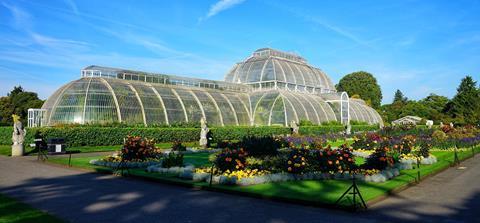
Microbiology or macrobiology?
When we see fungi in our daily life, such as mushrooms or moulds, it might not be immediately obvious why or how they relate to microbiology.
Dr Irina Druzhinina, a Senior Research Leader in the Fungal Diversity and Systematics team at Royal Botanic Gardens, Kew, explains: “When we talk about fungi, most people think about the mushrooms and other fungi visible to the human eye. Fungi can, of course, be huge – in an extreme example a single individual of honey fungus was found to colonise the underground of a whole forest and has been listed as one of the largest organisms on earth.
“Yet, a major part of the lifecycle of most fungi is microscopic, and in some cases they remain microscopic during their whole lifecycle. Hence, the study of fungi is definitely an important part of microbiology and I consider myself a microbiologist.”

The microbiome is important for plant health
Researchers at Kew are trying to understand the role that microscopic fungi play inside plants. Just like humans and other animals, plants also have a microbiome living inside their bodies that may play a role in the plant’s ‘immune system’.
Dr Ester Gaya, Senior Research Leader in the Comparative Fungal Biology team at Kew, is interested in the plant microbiome: “Millions of microbes, including fungi, live inside plants forming complex microbial communities.
“We think that plants that have a healthy microbiome are more resilient to stress and disease.
“I study fungal endophytes in particular, they are a group of diverse microfungi that live asymptomatically within plant tissues including their leaves, stems and roots. One of the stresses that fungal endophytes can help plants deal with is high temperatures – and better understanding this could help us deal with climate change.
“The first step to study these microscopic fungi is to know who is in there and what they are doing. At Kew, we are assessing the diversity of fungal endophytes across different plant species and habitats. We are also investigating their genomes and comparing them to plant fungal pathogens. Distinguishing between friend and foe is of major economic and ecological significance when talking about plant health, and using genomic tools can provide insight into the genetic determinants of these fungal lifestyles.”
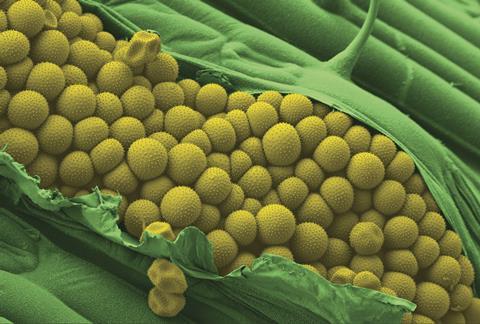
Fungi could also keep seeds healthy
Dr Gaya’s work on trying to better understand fungal diversity led her to go searching for fungal endophytes associated with seeds in Kew’s Millennium Seed Bank: “We went to the seed bank on the hunt for new fungi and in the hope of better understanding fungal interaction with seeds.”
The research project provided some interesting insights. Dr Gaya explained: “Our work threw open a Pandora’s box – we found an even more diverse range of fungi associated with seeds in long term storage than any of us had expected to see.”
The Kew Millennium Seed Bank is based in Sussex and has over 2.4 billion seeds from around the world, conserving them for the future in flood, bomb and radiation-proof vaults. Dr Ester Gaya and her team sequenced endophytic fungi they could find in seed samples:
“Interestingly, those seeds with particularly diverse fungal communities had a higher seed viability and germination rate. We don’t know yet if this is simply a coincidence or if fungi are helping keep the seeds healthy.
“We also showed that the fungal communities we found on seeds varied depending on the environment they came from.
“Seeds collected from habitats less disturbed by humans – such as jungles – had ‘healthier’ fungal communities associated with them. Conversely, seeds with poorer quality associated fungi were taken from more disturbed environments – such as beside a road or on a plantation. So we wonder if seeds from more urban environments are losing fungal partners that could be critical to keep them healthy in the longer term.”
Dr Gaya stresses it is important that we do more research in this area: “We need to keep describing this fungal diversity because we just don’t have enough information about it at the moment. We need to understand what combination of fungi keeps different seeds and plants healthy, and which environments promote this mix. This knowledge may help us develop the next generation of biofertilisers, consisting of synthetic microbial communities tailored for each crop and ecosystem, and may provide an important way to increase the yield of food and other agricultural crops.”

Spotting a friend or foe
Researchers are trying to understand the properties which make microfungi harmful or beneficial to plants – and are hoping that as more fungal genomes are sequenced they will be able to predict the most likely impact on plants. The findings so far have not been straightforward, according to Dr Gaya: “We can’t always see genetic signatures for why some fungi are pathogenic and others are beneficial – you can’t put fungi into boxes that easily.
“Instead, we see a continuum of ecological strategies with multiple transitions. For example, a fungus that may act as a beneficial endophyte in a particular environment, may shift into pathogenicity and attack the plant host if external factors change and put the plant under stress. This scenario becomes particularly important when we talk of invasive species, globalisation and global trade. Fungal species that may have evolved a beneficial interaction with their hosts in their original habitats can become pathogenic when colonising new environments and hosts.
“A prime example of this is the case of Hymenoscyphus fraxineus causing the ash die back disease in the UK, but being harmless to Asian native hosts.
Dr Gaya continued, “Another example is Fusarium wilt that has had a hugely negative impact on farmed banana plants, leading to worldwide banana shortages. Yet, we found related Fusarium species associated with wild banana seeds in the Millennium Seed Bank that appeared to be harmless to the seeds. This really shows how much we have to learn about how fungi impact on plant health in different circumstances.”
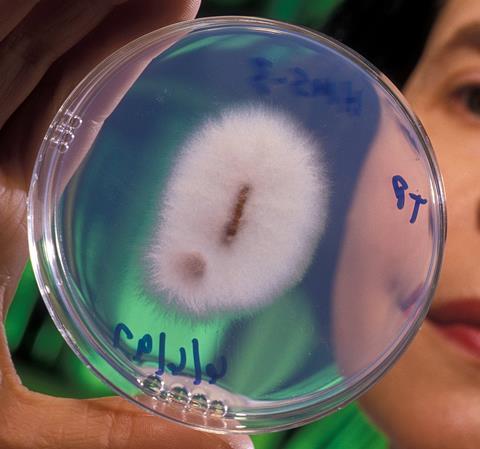
Underground relationships
There are also complex interactions between fungi and plants beneath the ground. Perhaps the most well-known of these are the mycorrhizal fungi that have a mutually beneficial relationship with plants. These fungi get sugars and other nutrients from the plant, and in return, the fungi help the roots absorb water, nutrients and minerals, in particular phosphorous.
The nature of these under-the-ground interactions have also been shown to change depending on the conditions. A recent study by Dr Druzhinina and her Chinese and French colleagues demonstrated that the interaction between plants and fungi might depend on the availability of nitrogen in the environment.
This research showed that in “normal” conditions, the root-associated fungus, Clitopilus hobsonii or Miller’s Oysterling, forms mutually beneficial mycorrhizae-like structures that support the mineral nutrition of poplar seedlings. However, when nitrogen is mainly available in the form of nitrate, the fungus becomes an aggressive pathogen.
Dr Druzhinina, commented, “This study suggests that the soil and water pollution from modern farming practices may affect the plant and ecosystem health a lot deeper than we recently could have imagined and that microfungi are key mediators of this.”
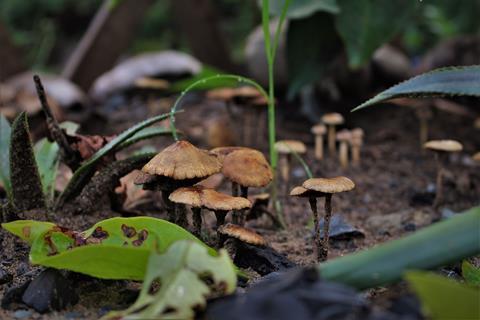
Hacking the plant immune system
Microfungi can even have an impact on plants if they are not in direct contact with them. Dr Druzhinina, works on one such type of fungi that lives in soil and decaying wood known as Trichoderma. Species of Trichoderma are mould fungi and are parasites of other fungal species.
Scientists think that Trichoderma lives in the soil around the roots, hunting fungi that do interact with the plant. Despite the fact they don’t always come into direct contact, plants detect the presence of Trichoderma and wrongly recognise the fungus as something that could harm it. This leads to the plant turning on defence mechanisms in a way that stimulates growth, defence and fitness.
Dr Druzhinina explains: “The properties of Trichoderma were first recognised over 20 years ago and their potential for boosting plant health is huge. We now see commercial use of Trichoderma as a biofungicide because it can kill plant-pathogenic fungi, and as a biofertiliser because crops provide greater yield when Trichoderma is added to soil.
“Trichoderma is a safe way to protect plants – we employ fungi which will not even associate with the plants. Their effect is very indirect. The main goal for scientists now is to understand the diversity of plant-fungal interactions in order to select the most suitable fungal friends to protect the plant from pests and make them more resilient to stress.

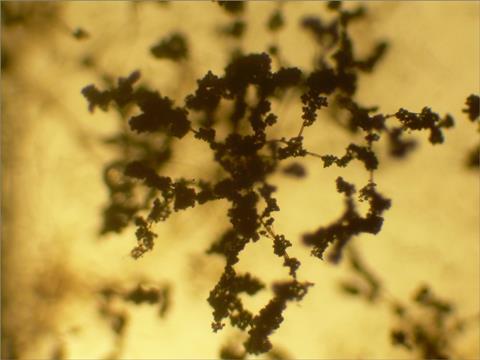
Fungal genome revolution
Recent years have seen a coordinated international effort to sequence fungal genomes. Dr Druzhinina explains: “We are seeing a molecular revolution when it comes to fungi, which is helping us better understand Trichoderma and other groups of fungi. In recent years, the international research community has come together to collaborate on the 1000 fungal genomes project run by Mycocosm at the Joint Genome Institute in Berkeley National Laboratories. This project is attempting to map out the fungal tree of life and better understand the complexity of fungi. My research group has contributed to another sequencing project, Trichoderma 400 , which aims to sequence the genomes of all species of these plant-beneficial fungi.
“The pace of discovery in this fungal group is remarkable. When I was born, scientists only knew of only one species of Trichoderma, when I graduated there were seven known species, by the end of my PhD we knew of 42 species, now we know of 420. As we learn more, I expect we will see more applications of Trichoderma and other fungi in sustainable agriculture.”
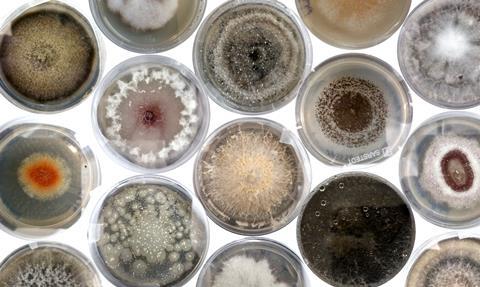
Finding and training the next generation of fungal researchers
While fungal research is going from strength to strength, it is not an area that many microbiologists choose to study. Dr Gaya says the demand for mycologists is high: “At Kew we have lots of companies coming to us asking for our expertise in mycology – giving advice on applications ranging from agriculture to sportswear.”
“The rapid progress in fungal genomic research means expertise in fungi is in high demand. However, fungi have managed to escape the UK education system. Students are not taught about fungi at GCSE or A-level beyond a tiny bit in the sections about evolution and the tree of life. Universities usually offer courses on botany with fungi being facultative or supplementary, or as part of medical courses.”
“At Kew we are on an important mission to train the next generation of mycologists. Kew is an excellent place for this because of its unique collections and expertise. Nowhere in the world you will find such a great combination of plant and fungal experts working together. There are many brilliant fungal jobs out there for the taking! Students and young scientists pursuing a fungal career will be in high demand.”
Dr Druzhinina adds: “I came to this area of research because I was always fascinated by plants as a child. But I felt I already knew enough about plants by the time I got to university, so I chose to study fungi instead. I graduated in mycology, but the department I studied in was actually part of botany — there are very few university departments that are focused on mycology. However, the incoming new data on fungal diversity worldwide and the advances in genetic and genomic studies make mycology, including microfungi, a hotspot for biological ‘big data’ and biotechnological applications.”
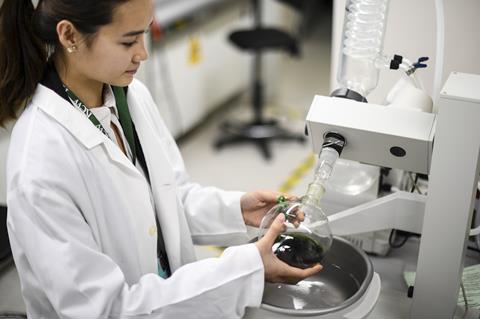
A critical moment for microfungal research
“Fungi are overlooked because of their nature, because they often grow inside their food, and are frequently developing as part of another living organism. They are not as apparent as plants or animals. This means they get left behind when it comes to research funding.
However, Dr Druzhinina believes the future is bright for this field of research: “We are making so many big leaps forwards in our understanding of fungi and their applications – and there is an ocean of discovery still to explore. That makes this field one of the most exciting to be in right now.”
In conclusion
With such great leaps in understanding of the role of microfungi in recent years, it is clear that the future is bright for this area of research. As our agriculture and ecosystems face unprecedented challenge from climate change and pollution, scientists at Kew and elsewhere will continue to look for ways to harness the unique properties of fungi to boost plant health – exploiting this very old relationship.
Further Reading
If you find it interesting to refer to the articles published by Applied Microbiology International, you may refer to a few of our recent studies on Trichoderma:
https://ami-journals.onlinelibrary.wiley.com/doi/10.1111/jam.14751
https://ami-journals.onlinelibrary.wiley.com/doi/10.1111/1462-2920.12966
https://ami-journals.onlinelibrary.wiley.com/doi/10.1111/1462-2920.15413
File:Trichoderma conidiophores 16X.png - Wikipedia, the free encyclopedia








No comments yet